Beelink GTR5 GR9 Internal Hardware Overview
Starting with the bottom of the system, to get inside there are four screws located under the massive rubber strips. It is a bit harder to get inside than some other systems that use a single screw, but not too bad. To pull the bottom cover off, one can see the little tab. This is a Beelink logo tab that one can use to get to the user-serviceable portions of the system.
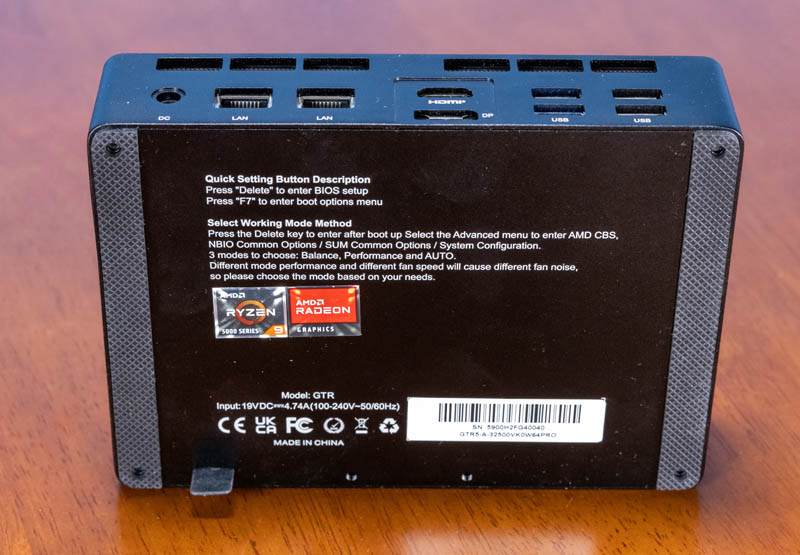
Inside, we get a system that is very straightforward and easy to service. We will note that the Seagate IronWolf Pro is being used here just to show the 2.5″ mounting point but it did not come with the system.
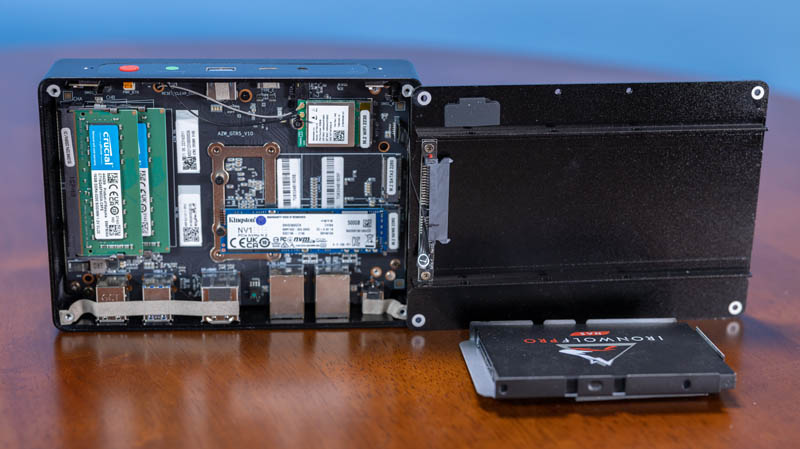
The SATA connection is to the bottom cover. Beelink also has a cover that goes atop the SSD. That 2.5″ cover also has a thick thermal pad that can be used to cool the M.2 SSD.
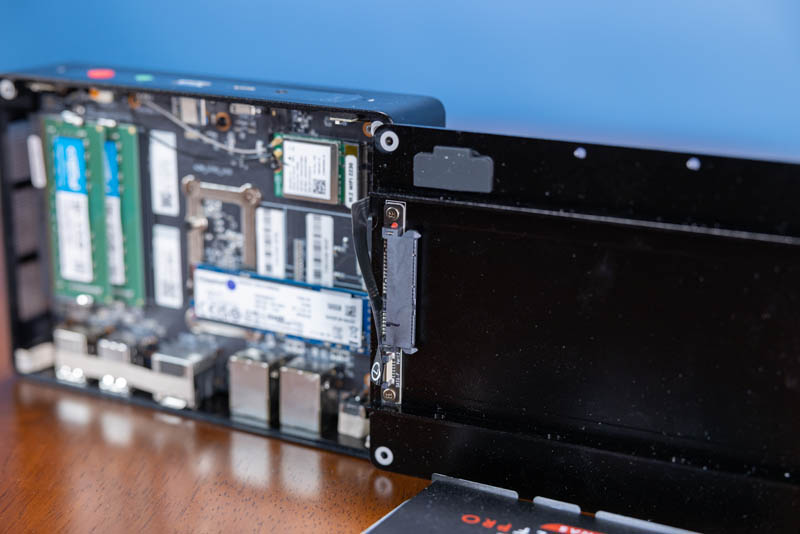
Inside the system, we have memory, the WiFi module, and the two M.2 slots that are easy to service.
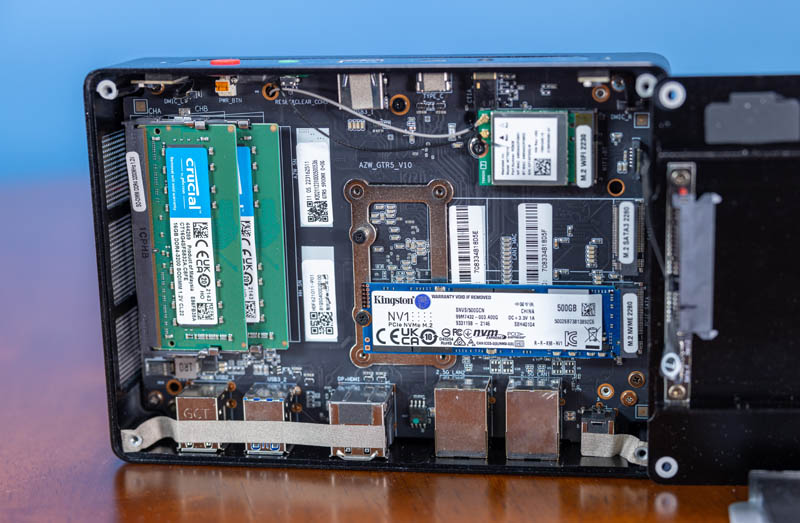
Memory is 32GB in our unit via two 16GB Crucial DDR4-3200 SODIMMs. It is nice to see Beelink is using a major brand here since some systems we have seen use ultra low cost and less reliable RAM and SSDs.
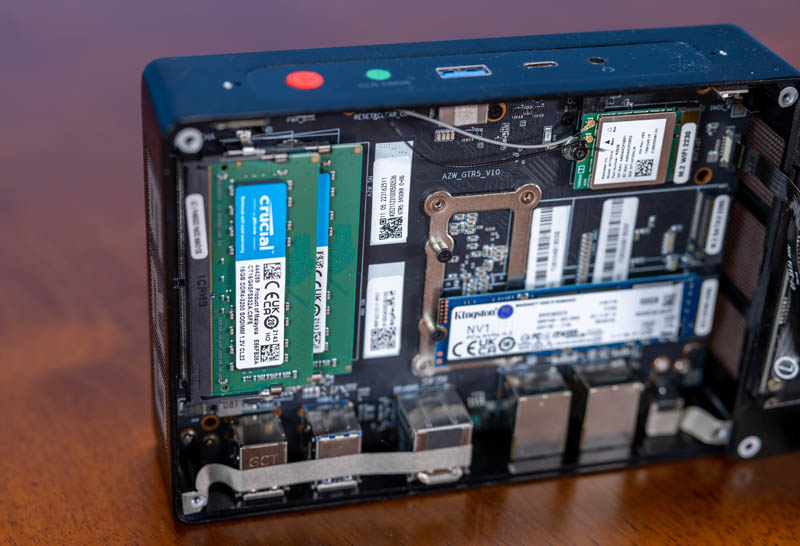
WiFi is interesting. This system has a MediaTek WiFi 6E part. It is nice that this is a WiFI 6E module, but generally, Intel has a much larger market share to driver support tends to be better. In Windows, this is less of a concern.
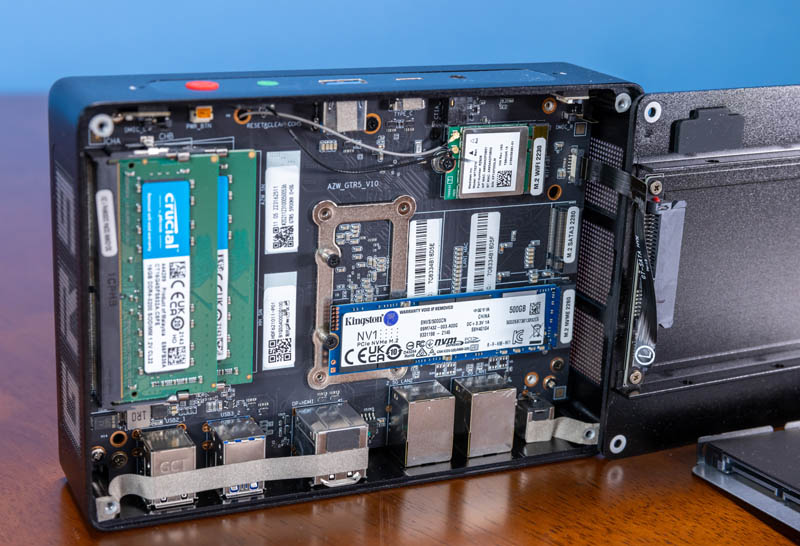
Beelink also has a Kingston NV1 NVMe SSD. In our case, this is a 500GB PCIe Gen3 drive which is not a Gen4 drive but is still a nice drive in this class of machine. There is a second M.2 slot above the NVMe slot and this is labeled as a M.2 2280 (80mm) SATA SSD slot so there is actually quite a bit of storage expandability despite the small package.
Next, let us get to the performance.
Beelink GTR5 GR9 Performance
Instead of going through the entire Linux-Bench test suite, we are going to show a few performance and power numbers here to give a general sense of performance. This also gives us the opportunity to test with Linux/ Ubuntu instead of just Windows.
Python Linux 4.4.2 Kernel Compile Benchmark
This is one of the most requested benchmarks for STH over the past few years. The task was simple, we have a standard configuration file, the Linux 4.4.2 kernel from kernel.org, and make the standard auto-generated configuration utilizing every thread in the system. We are expressing results in terms of compiles per hour to make the results easier to read:
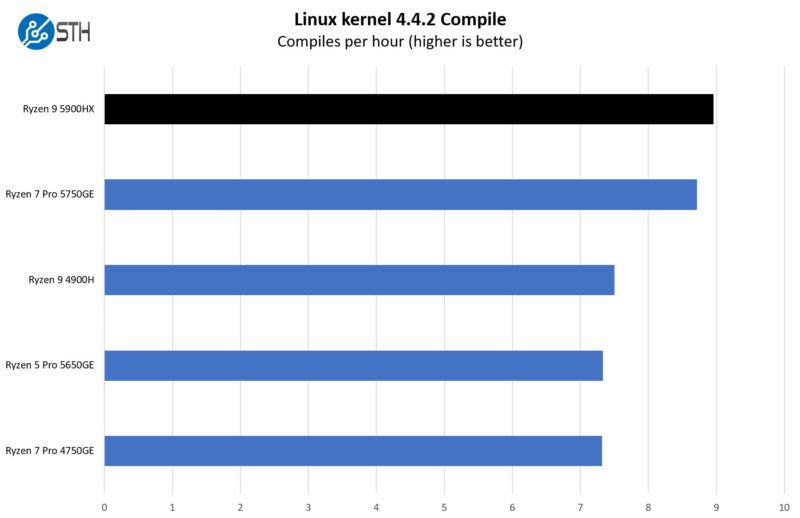
The AMD Ryzen 9 5900HX is fast, somewhere between the AMD Ryzen 7 Pro 5750GE and 5750G since TDP is the major differentiation point.
7-zip Compression Performance
7-zip is a widely used compression/ decompression program that works cross-platform. We started using the program during our early days with Windows testing. It is now part of Linux-Bench.
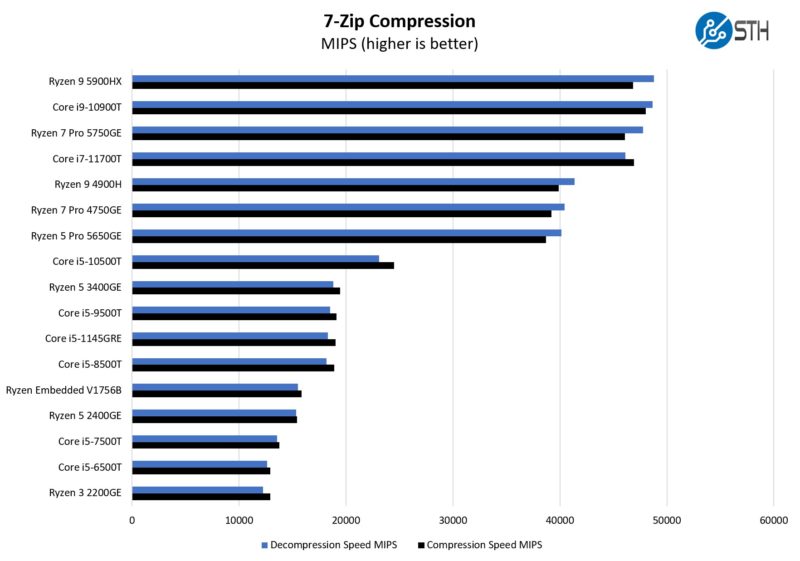
If we compare this small system to older generations, we can see having 8 cores and 16 threads of a modern AMD CPU is absolutely awesome here.
OpenSSL Performance
OpenSSL is widely used to secure communications between servers. This is an important protocol in many server stacks. We first look at our sign tests:
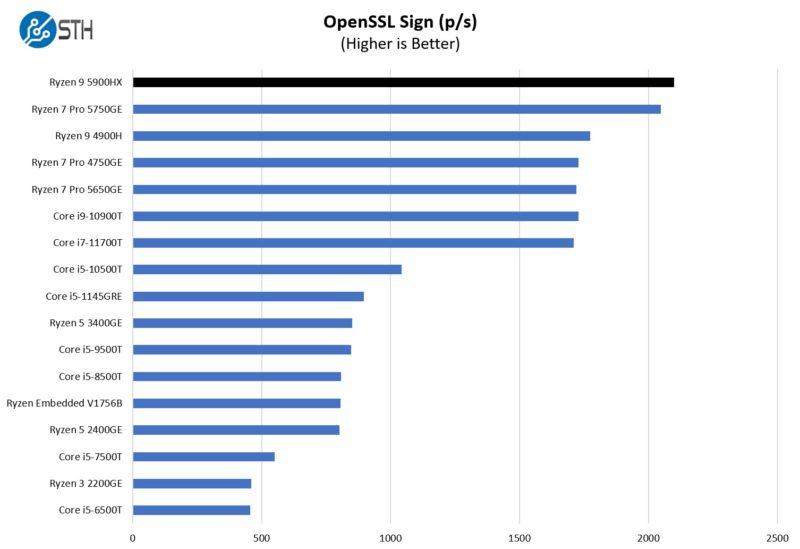
Here are the verify results:
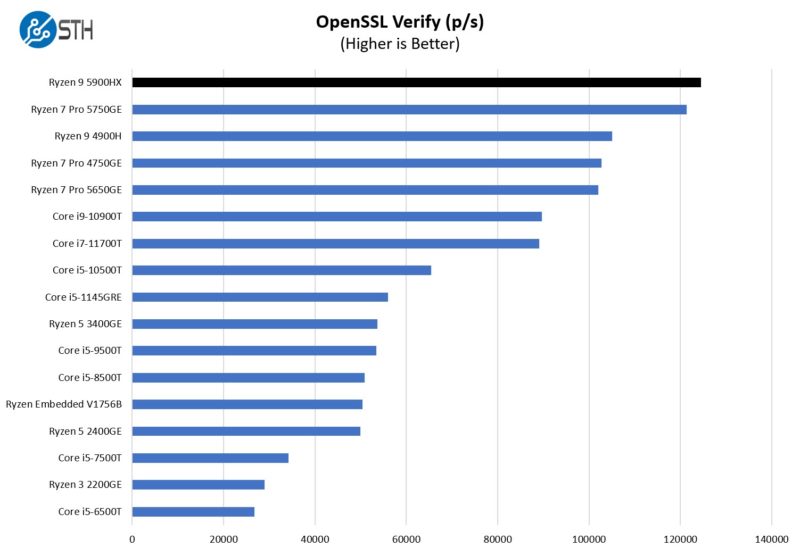
Also being fair here, the Ryzen 9 5900HX is a 45W TDP default CPU while many others on this list are older generations of 35W TDP parts, but it just shows how much faster the new CPUs are.
Kingston NV1 NVMe Performance
Although this is not necessarily the same depth that our SSD reviews go into, here is a quick CrystalDiskMark of the PCIe Gen3 SSD in the system:
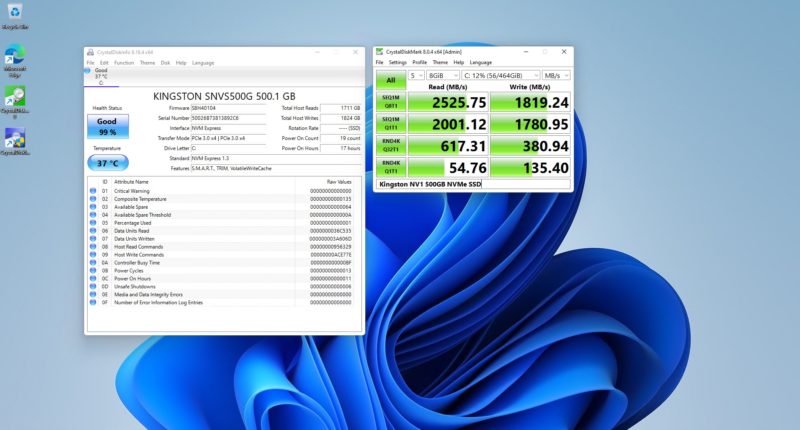
These are not necessarily chart-topping results compared to newer Gen4 SSDs, but this is very reasonable Gen3 performance. In a system like this, having good enough performance at reasonable temperatures is better than having a fast but super-hot SSD that overheats itself and everything around it.
Next, we are going to discuss power consumption before getting to our key lessons learned and wrapping up the review.




Reviews on Amazon complain about needing to set up an account with a biometrics company and nothing working till that was done. Another complained about spyware.
Was there any similar monkey business with this unit?
Can it run Linux? I guess so given the kernel compile benchmark was run. Does it require secure boot?
Mark – I just used Windows Hello and it worked out of the box so I guess I was using Microsoft.
We ran Ubuntu on it. There is someone in the YT comments saying they have been running Proxomx on it for 6 months and it has worked great for them.
At my old MSP we deployed these to our clients as desktops when we couldn’t get Lenovo M series. They’ve been a hit since, primarily because of the connectivity and just solid performance. We re-image by default, but in our labs we didn’t notice any spyware or biometric requirement….older model (blue ryzen 3750 ones) but really very similar product. I asked my buddy who still works there…never had to RMA one yet (~20 in the field).
How loud this thing gets ?
These things are more often than not heavilly overpriced crap.
They charge an arm&leg for an SoC on very limited MoBo, cheap enclosure and custom, usually very constrained cooler.
Ofcourse, without a chipset – whole board is essentially Ryzen with VRM and connectors.
I also don’t understand why is it so painful for them to route out what’s already available on SoC.
Why is it so rare to see, for example, 4 Displayport outupts when chips do offer them ?
You benchmark Ryzen processors over several generations but there’s no newer generation Intel up there in the benchmark. For a review from june 22, I would awaited a comparison between the latest tech. Could you guys add 12gen intel and hit the article with an “update”?
Not everyone needs massive levels of versatility in their computing experience and these mini-PC’s fill a niche. They don’t require large levels of expertise to operate, are simple to just plug in and don’t require large levels of desk space and air space for heat removal. Many can game reasonably well and don’t suck up the power bill while doing so.
It’s not surprising to see the MediaTek wireless solution on AMD boxes, since MediaTek and AMD have co-branded (and offer package deals on) these in an effort to compete with Intel. I bet the module says “Part Number: RZ608” (the AMD product name) on it?
MediaTek wifi is actually quite well supported on Linux, but the driver fixes for MT7921K aka RZ608 modules only got implemented very recently – you’ll need to use a 5.17 kernel or later.
I have one of these. I’m using it to learn Proxmox before I deploy Proxmox onto a large, much more complex (in terms of hardware) server.
I’m loving it so far. I do have a couple of questions I’m hoping someone else here might already have found the answer to.
1) With Proxmox/a non-Windows OS installed, will the fans still work correctly? If the BIOS is controlling them, I don’t need to worry about it, but if the OS is supposed to control them, PVE won’t know how to do that, and I need to do … something. (Install fancontrol and configure that?)
2) How do I update the BIOS/Firmware? The site is a bit confusing and I’m not sure what to download. There’s a “Flash Firmware” tool from August 2022 on their website, but it’s not clear from the download page that it applies to my machine.
See: https://www.bee-link.com/cms/support/driverhardware?product_id=&keyword=&categoryId=78
Hi i agree the branding is very confusing but my main issue is that i cant get the system to run at above 30 htz refresh rate.
any help would be appreciated
I had the same one but my motherboard gave out only had it 9 month’s not even a year and I took it to a PC repair shop and I waited 1-3 days and he called me and said he couldn’t fix it and couldn’t find another motherboard for it is their motherboards I can find to replace it.